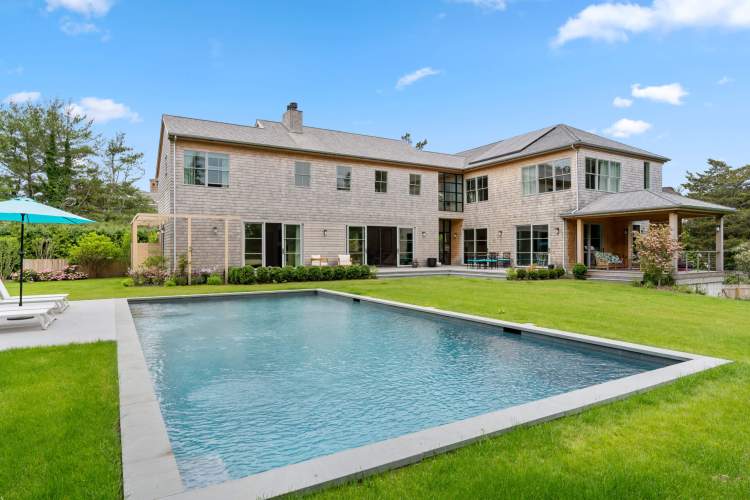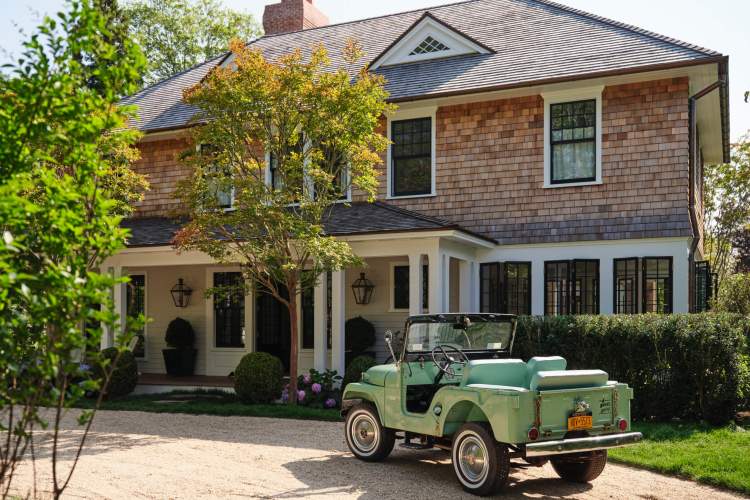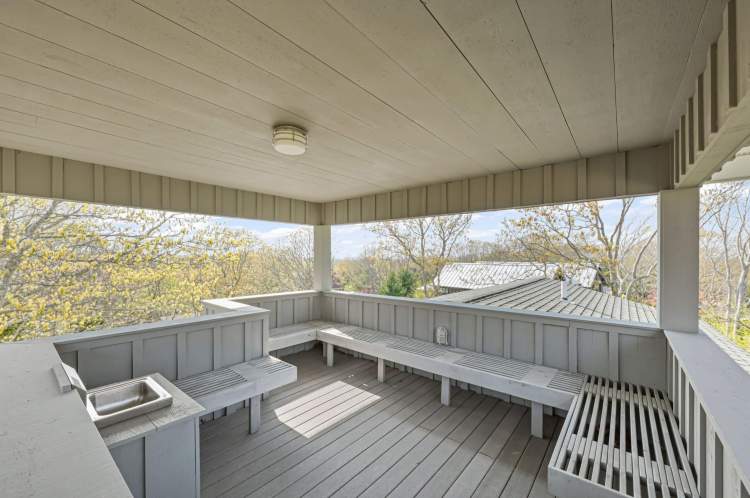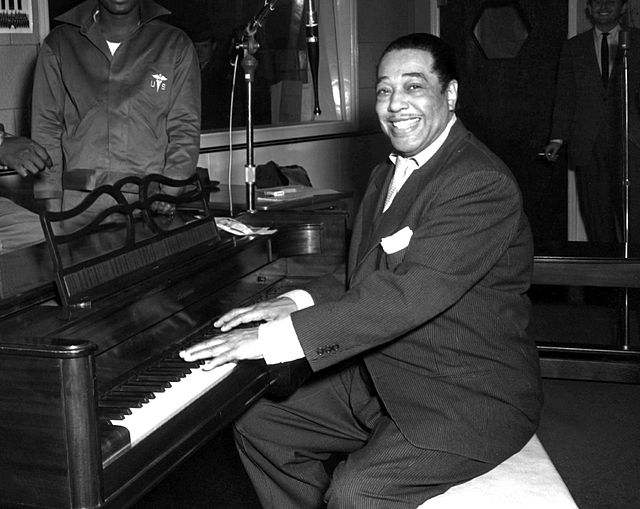In the Rogers Mansion may be found the entire story of Southampton, if not all of the East End. This rambling white clapboard building has been moved, added to, renovated and changed for many long years to suit the needs of its inhabitants: farmers, whalers, merchants in the early days and wealthy doctors and lawyers during the summer colony period.
Today, the 17-room house is a mishmash of styles, from Greek Revival to Colonial to Colonial Revival. A one-story gabled barn is attached at the rear, and Doric pilasters, a balustrade on the roof and a cupola decorate the exterior.
The history of the property begins in 1648, just eight years after Puritans landed in Southampton from Connecticut. William Rogers (1606-1667) was allotted about nine acres by the Southampton Town proprietors when the second settlement, now the village, was laid out. Rogers, who was raised in England, moved to Connecticut before 1640, and was known to have been in Southampton before 1644. Rogers owned large amounts of property in Southampton, but he was also involved with settling of the town of Huntington.


By 1655, his son Obadiah Rogers lived in the house on this land; William having probably moved with the rest of his family to Huntington. It is unknown exactly what form the house took, but it was likely a two-story saltbox. Obadiah also seems to have been a wealthy and respected man; at various times he held official positions such as Constable, Overseer, and Juror. (New York colony insisted that citizens had a right to a trial by jury at the time, but jurors had to be white men who owned property.)
After Obadiah’s death, Obadiah Junior inherited, and after him, Obadiah III was the owner. Capt. Obadiah Rogers (1699-1783) was Town Clerk of Southampton for several years, as well as Trustee, Overseer of the Poor, and Fence Viewer. Don’t laugh–in a farming town, the person who made sure fences (often hedges) were on the right boundaries was very important. In fact, Southampton up till about Revolutionary times was heavily bordered with privet hedges; many of them were cut down then because it was thought the smell of their flowers made people consumptive.

Obadiah had the title of captain for serving in the Revolutionary War–on the wrong side! He was captain of the English schooner Britannia, which was captured in 1777 by a sloop portentiously named America. He was also a whaling captain who hired Shinnecocks to work his ships.
Obadiah III’s son, Captain Zephaniah Rogers (1742-1796), also served in the Revolutionary War, for the American side. He is listed as a minuteman in the First Regiment of Suffolk County. Zephaniah was also a whaling captain and a merchant. (In case you’re wondering, Obadiah III had no children called Obadiah.)
Zephaniah, who had six children, enlarged the Rogers house around 1780. Much of the back of the house today bears unmistakable signs (framing, windows) of late-1700s construction. Zephaniah’s son Herrick married a member of the Rose family. He too was a merchant and a whaler; in 1807 he expanded the family’s wealth by buying 15 more acres at Old Town.
In 1842, Herrick’s son Captain Albert Rogers inherited the property, the sixth generation of the family to own it. Albert was a whaler and a very successful one; for most of nine years he was away whaling. He made a great deal of money from the lucrative trade, and it’s he who enlarged and revamped the house in the fashionable Greek Revival style in 1843. Generally speaking, when you see a Greek Revival house in the Hamptons, the money to build or renovate was made via whaling.

Unfortunately for Albert, the whales got him in the end. He no longer went to sea to whale, but he did “protect” Southampton from whales locally. (People in the 1840s and 1850s saw whales as malevolent beasts.) In 1854, Albert harpooned a whale off Southampton; the whale smashed into the boat and injured Albert’s leg with its tail. He died of gangrene several weeks later.
 Albert left his property to his second wife, Cordelia Rogers. (Interestingly, staff today at the mansion have experienced odd, possibly supernatural phenomena, and it’s assumed that the ghost is either Cordelia or her sister Mary, Albert’s first wife.) The Rogers children were young at the time of their father’s death, but they gradually moved away when they grew up. Captain Jetur Rogers, the middle child, went to live in what is known now as the Fairfield Porter house in Southampton, while the daughter and other son moved to Wisconsin. Cordelia herself moved to Wisconsin in 1871. The house appears to have been left empty until her death in 1887. In between 1871 and 1887 Cordelia sold much of the land, which eventually dwindled to just 1.71 acres. Cordelia left her property to her three children equally: they sold the house to Dr. John Nugent for $12,000 in 1889.
Albert left his property to his second wife, Cordelia Rogers. (Interestingly, staff today at the mansion have experienced odd, possibly supernatural phenomena, and it’s assumed that the ghost is either Cordelia or her sister Mary, Albert’s first wife.) The Rogers children were young at the time of their father’s death, but they gradually moved away when they grew up. Captain Jetur Rogers, the middle child, went to live in what is known now as the Fairfield Porter house in Southampton, while the daughter and other son moved to Wisconsin. Cordelia herself moved to Wisconsin in 1871. The house appears to have been left empty until her death in 1887. In between 1871 and 1887 Cordelia sold much of the land, which eventually dwindled to just 1.71 acres. Cordelia left her property to her three children equally: they sold the house to Dr. John Nugent for $12,000 in 1889.
Nugent was the son of Irish immigrants who was born in Riverhead. Though a medical doctor, he also partnered with Southampton native Lemuel Wick in a drug store called Wick & Nugent on Jobs Lane. Sadly, the partnership only lasted about a year, because Wick was also illegally selling liquor without a license on the side. Nugent eventually became the chief doctor and coroner of Southampton.

Nugent added on to the house and remodeled it somewhat into a fashionable Southampton mansion. He added dormers, a full-width porch to the facade, and a gable to the 1780s part, as well as bay windows. Presumably the older parts of the house had tiny Colonial windows, no longer in fashion. After that, the house was now a trophy and a landmark in Southampton. Nugent was persuaded to sell by none other than Southampton luminary Samuel Parrish (1849-1932).
Parrish was a wealthy lawyer who originally used the property as a summer house. He is one of the founders of the Shinnecock Hills Golf Club, helped establish the Shinnecock Hills Summer School of Art along with William Merritt Chase, and built the Parrish Art Museum in 1897 to house his personal art collection. He also helped found the Rogers Library and Southampton Hospital.
Parrish’s favorite architectural firm was McKim, Mead & White. He had the firm design a summer house for his mother, the clubhouse for the Shinnecock Golf Club, and the house and studio of William Merritt Chase. So naturally he turned to the company when he decided to remodel the Rogers Mansion, although it is uncertain today which changes were made by the firm and which possibly by the firm’s former apprentice, architect Grosvenor Atterbury. Parrish almost doubled the size of the house, adding a music room, a billiard room, additional bedrooms and a powder room. In 1926, he moved the house one hundred feet back from Main Street to its present site with the entrance on Meeting House Lane.
Parrish’s heirs owned the house until 1943 when the Village of Southampton purchased it for $4,000. In 1952 the Southampton Colonial Society (known now as the Southampton Historical Museum) began leasing the house and grounds, just as they do today. Visitors to the museum can see many artifacts of previous owners, including whaling souvenirs from Asia, a fire insurance policy document purchased by Captain Albert Rogers in 1840, one of Dr Nugent’s old prescription pads, and Parrish’s walnut piano. Today, the Rogers Mansion displays 300 years of Southampton history–and lives well lived–in one house.






















